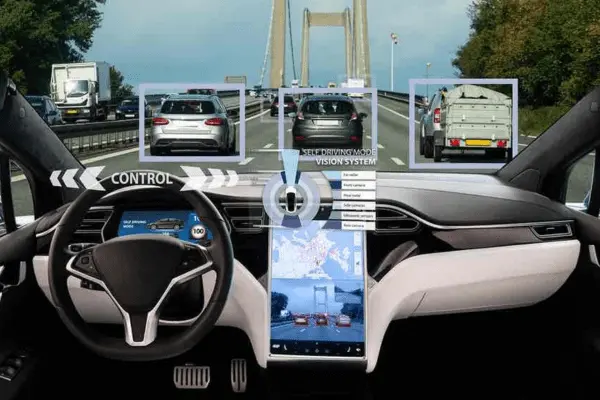Introduction:
Autonomous vehicles are gaining attention for their potential to transform transportation. Using advanced autonomous vehicle software, they navigate without human input. This overview explores key components, challenges, and advancements in autonomous technology.Crucial components of autonomous vehicle software:
Autonomous car software is a complicated system composed of several key components:
- Perception: To sense its surroundings, the car’s perception system uses sensors such as cameras, radar, LiDAR, and ultrasonic sensors. These sensors detect surrounding cars, pedestrians, traffic lights, and road conditions.
- Localization is necessary for the car to understand where it is precisely on the road. GPS, map data, and inertial measurement units (IMUs) are used for accurate localization.

- Mapping: High-definition maps are needed for autonomous vehicles. These maps detail traffic signs, lanes, and roads, helping cars make informed decisions.
- Control: The control system evaluates information from mapping, localization, and perception to make real-time driving decisions. It controls the vehicle’s brakes, steering, and acceleration for safe navigation.
- Making Plans and Decisions: The planning module plots a path for the car using maps and the observable environment, and the decision-making section considers the advantages and disadvantages of each choice before selecting the most sensible and safe course of action.
Advancements in Software for Autonomous Vehicles:
Lately, there have been notable advancements in the field of autonomous vehicle software, particularly in the following domains:- Artificial intelligence and machine learning: Machine learning algorithms are improving the vision and decision-making capabilities of self-driving cars by enabling them to process information from the real world and adapt to new situations.
- Simulation: robust simulation environments can do away with the need for in-person testing by allowing developers to test and validate autonomous software in various scenarios.
- Communication: Through V2X (vehicle-to-everything) communication, autonomous vehicles can increase efficiency and safety by exchanging data with other vehicles, the traffic system, and pedestrians.
- Updates via Over-the-Air (OTA): Over-the-air (OTA) software updates allow autonomous automobiles to obtain regular software upgrades by fixing security problems and improving performance.
Autonomous Vehicle Software Benefits
Autonomous vehicle software, sometimes known as self-driving car software, offers several possible benefits. These benefits have the potential to revolutionize transportation while increasing effectiveness and security. Some of the primary benefits of autonomous automobile software include the following:- Enhanced Safety: The frequency of collisions caused by human mistakes, such as speeding, distracted driving, and drunk driving, could be significantly reduced by autonomous cars. The software’s capacity to follow traffic regulations, maintain safe distances, and make quick, accurate decisions may result in fewer accidents.
- Decreased Traffic Congestion: Autonomous vehicles can ease traffic congestion by communicating with one another and the traffic infrastructure. This can improve the overall efficiency of transportation networks and reduce traffic congestion by removing roadblocks.

- Enhanced Accessibility: Autonomous vehicles may provide greater mobility to the elderly, people with disabilities, and people unable to drive because of health issues. This could significantly improve their level of independence and quality of life.
- Environmental Benefits: Programming autonomous vehicles can reduce emissions and fuel use. Electric and driverless vehicles could reduce air pollution and emissions.
- Decreased Parking Need: Self-parking autonomous cars that can also pick up and drop off passengers can reduce the need for parking spaces in urban areas, making better use of expensive real estate.
- Economic Benefits: The creation and application of autonomous cars have the potential to provide jobs in a variety of industries, from software development to vehicle maintenance. Additionally, industries like ride-sharing and delivery services may benefit.
- Better Mobility Services: Autonomous technology can offer shared mobility services that are available on demand, saving users money and enhancing travel convenience. Additionally, it might lessen the need for individual car ownership.
Cons of Software for Autonomous Vehicles
Despite its benefits, autonomous vehicle software faces key challenges that developers must address. Some disadvantages and problems with autonomous car software are as follows:- Safety and reliability: Despite developments, concerns about the dependability and security of self-driving automobiles persist. Software problems, technical malfunctions, and the ability to handle complex and unexpected situations are examples of ongoing challenges.
- High Development Costs: Developing and testing software for self-driving cars is an expensive and resource-intensive procedure. This cost can be an entry hurdle for many enterprises, which could result in increased car prices.
- Cyber-attack vulnerability: autonomous automobiles rely heavily on software and data transfer. As a result, they become more vulnerable to cyberattacks, jeopardizing their security and safety. Being safe from online threats is among the top worries.

- Legal and regulatory challenges: The laws and rules governing autonomous vehicles are ever-changing. Assigning blame for failures is challenging, hindering adoption. Autonomous vehicles may also displace drivers, disrupting industries like haulage, taxis, and deliveries.
- Ethical Conundrums: For example, autonomous vehicles may have to choose between preventing an impending collision and safeguarding the occupants of the vehicle or pedestrians. It’s not easy to resolve these moral dilemmas.
- Privacy Issues: Autonomous vehicles gather and retain a lot of data, including location and private passenger information. Ensuring data privacy and security is crucial to prevent misuse or breaches.
- Restricted Accessibility: Some socioeconomic groups may not be able to employ autonomous technology because of its expensive cost, which could result in unequal access to transportation options.


